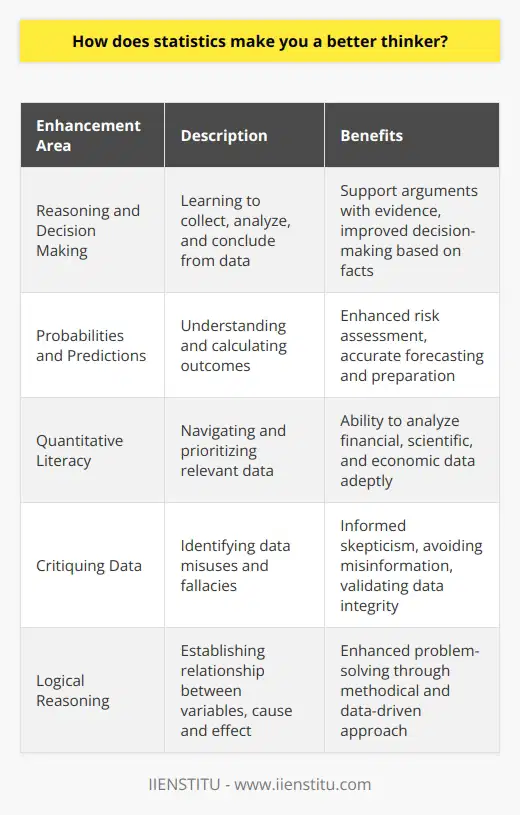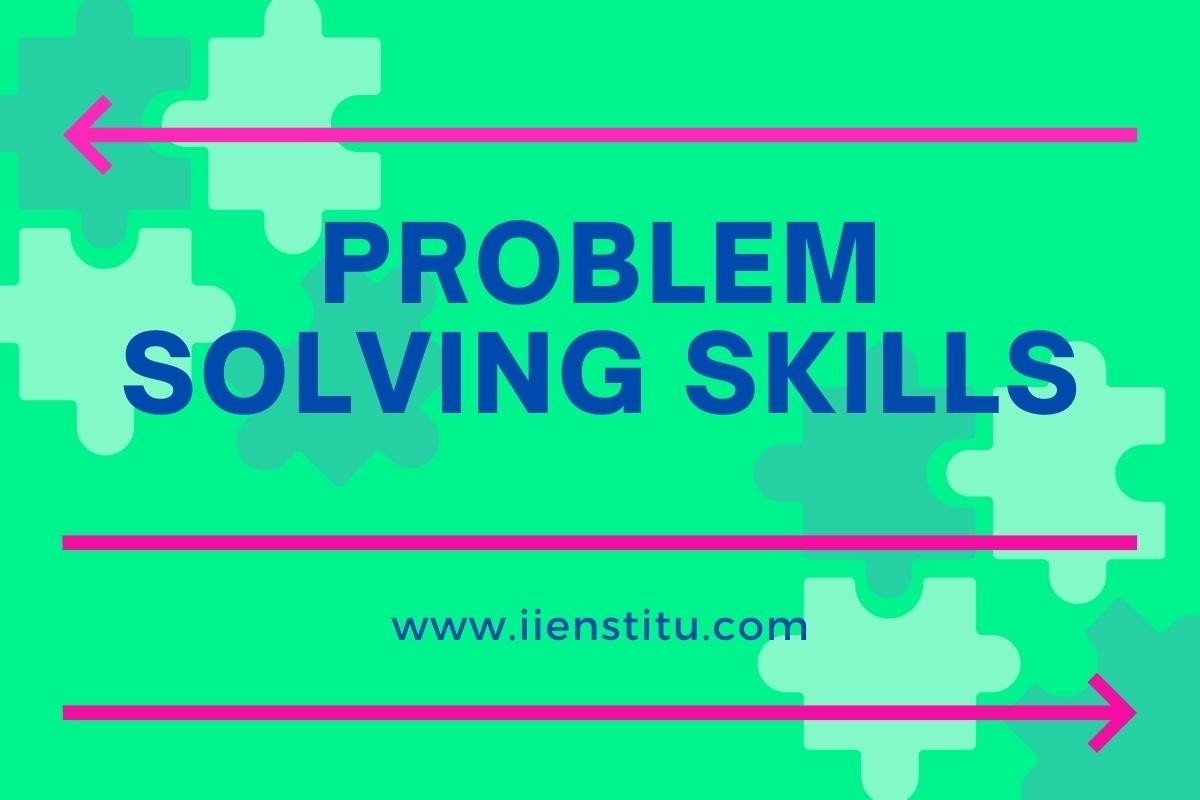
Problem-solving is an essential skill that everyone must possess, and statistics is a powerful tool that can be used to help solve problems. Statistics uses probability theory as its base and has a rich assortment of submethods, such as probability theory, correlation analysis, estimation theory, sampling theory, hypothesis testing, least squares fitting, chi-square testing, and specific distributions.
Each of these submethods has its unique set of advantages and disadvantages, so it is essential to understand the strengths and weaknesses of each method when attempting to solve a problem.
Introduction
Overview of Problem-Solving
Role of Statistics in Problem-Solving
Probability Theory
Correlation Analysis
Introduction: Problem-solving is a fundamental part of life and an essential skill everyone must possess. It is an integral part of the learning process and is used in various situations. When faced with a problem, it is essential to have the necessary tools and knowledge to identify and solve it. Statistics is one such tool that can be used to help solve problems.
Overview of Problem-Solving
Problem-solving is the process of identifying and finding solutions to a problem. It involves understanding the problem, analyzing the available information, and coming up with a practical and effective solution. Problem-solving is used in various fields, including business, engineering, science, and mathematics.
Role of Statistics in Problem-Solving
Statistics is a powerful tool that can be used to help solve problems. Statistics uses probability theory as its base, so when your problem can be stated as a probability, you can reliably go to statistics as an approach. Statistics, as a discipline, has a rich assortment of submethods, such as probability theory, correlation analysis, estimation theory, sampling theory, hypothesis testing, least squares fitting, chi-square testing, and specific distributions (e.g., Poisson, Binomial, etc.).
Probability Theory
Probability theory is the mathematical study of chance. It is used to analyze the likelihood of an event occurring. Probability theory is used to determine the likelihood of an event, such as the probability of a coin landing heads up or a certain number being drawn in a lottery. Probability theory is used in various fields, including finance, economics, and engineering.
Correlation Analysis
Correlation analysis is used to determine the relationship between two variables. It is used to identify the strength of the relationship between two variables, such as the correlation between the temperature and the amount of rainfall. Correlation analysis is used in various fields, including economics, finance, and psychology.
Estimation Theory
Estimation theory is used to estimate the value of a variable based on a set of data. It is used to estimate the value of a variable, such as a city's population, based on a sample of the population. Estimation theory is used in various fields, including economics, finance, and engineering.
Conclusion: Statistics is a powerful tool that can be used to help solve problems. Statistics uses probability theory as its base, so when your problem can be stated as a probability, you can reliably go to statistics as an approach. Statistics, as a discipline, has a rich assortment of submethods, such as probability theory, correlation analysis, estimation theory, sampling theory, hypothesis testing, least squares fitting, chi-square testing, and specific distributions (e.g., Poisson, Binomial, etc.). Each submethod has unique advantages and disadvantages, so it is essential to select the one that best suits your problem. With the right approach and tools, statistics can be a powerful tool in problem-solving.
Statistics are the key to unlocking better problem-solving skills - the more you know, the more you can do.
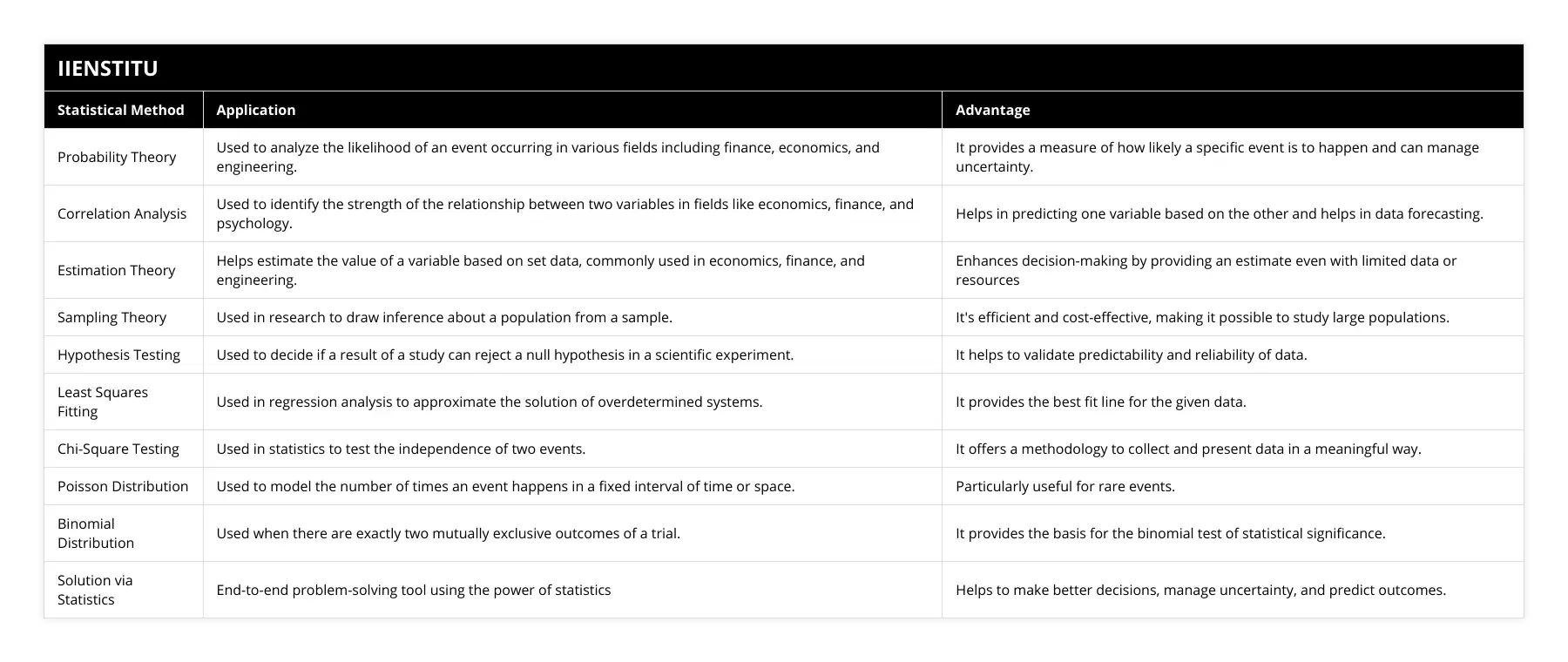
Frequently Asked Questions
What role does probability theory play in using statistics to improve problem solving skills?
Probability theory and statistics are both essential tools for problem-solving, and the two disciplines share an interdependent solid relationship. This article will discuss the role that probability theory plays in using statistics to improve problem-solving skills.
Probability theory provides a framework for understanding the behavior of random variables and their associated distributions. We can use statistics to make better predictions and decisions by understanding and applying probability theory. For example, when calculating the probability of a desired outcome, we can use statistical methods to determine the likelihood of that outcome occurring. This can be used to inform decisions and help us optimize our strategies.
Statistics also provide us with powerful tools for understanding the relationship between variables. By analyzing the correlation between two or more variables, we can gain valuable insights into the underlying causes and effects of a problem. For example, by studying a correlation between two variables, we can determine which variable is more likely to cause a particular outcome. This can help us to design more effective solutions to problems.
By combining probability theory and statistics, we can develop powerful strategies for problem-solving. Probability theory helps us understand a problem's underlying structure, while statistics provide us with the tools to analyze the data and make better predictions. By understanding how to use these two disciplines together, we can develop more effective solutions to difficult problems.
In conclusion, probability theory and statistics are both essential for problem-solving. Probability theory provides a framework for understanding the behavior of random variables, while statistics provide powerful tools for understanding the relationships between variables. By combining the two disciplines, we can develop more effective strategies for solving complex problems.

How can correlation analysis be used to identify relationships between variables when solving problems?
Correlation analysis is a powerful tool for identifying relationships between variables when solving problems. It is a statistical approach that measures how two variables are related. By analyzing the correlation between two variables, researchers can identify the strength and direction of their relationship. For example, a correlation analysis can determine if a change in one variable is associated with a change in the other.
When conducting correlation analysis, researchers often use Pearson’s correlation coefficient (r) to measure the strength of the association between two variables. This coefficient ranges from -1 to +1, where -1 indicates a perfect negative correlation, 0 indicates no correlation, and +1 indicates a perfect positive correlation. A perfect positive correlation indicates that when one variable increases, the other variable also increases, and a perfect negative correlation indicates that when one variable increases, the other variable decreases.
Correlation analysis helps identify relationships between variables when solving problems. For example, in a study of the relationship between dietary habits and body weight, a researcher may use correlation analysis to determine if there is a relationship between the two variables. Suppose the researcher finds a significant correlation between dietary habits and body weight. In that case, this can provide insight into the studied problem and help inform solutions.
Correlation analysis can also be used to identify causal relationships between variables. By examining the relationship between two variables over time, researchers can determine if a change in one variable is associated with a change in the other. For example, a researcher may use correlation analysis to determine if temperature changes are associated with changes in air quality. If a significant correlation is found, then the researcher can conclude that temperature changes are likely causing changes in air quality.
Overall, correlation analysis is a powerful tool for identifying relationships between variables when solving problems. By examining the strength and direction of the relationship between two variables, researchers can gain insight into the problem being studied and inform potential solutions.

What are the benefits of using estimation theory when attempting to solve complex problems?
Estimation theory is a powerful tool when attempting to solve complex problems. This theory involves making educated guesses or estimations about the value of a quantity that is difficult or impossible to measure directly. By utilizing estimation theory, one can reduce uncertainty and make decisions more confidently.
The main benefit of using estimation theory is that it allows for the quantification of uncertainty. By estimating, one can determine the range of possible outcomes and make decisions based on the likelihood of each outcome. This helps to reduce the risks associated with making decisions as it allows one to make better decisions based on the available data.
Another benefit of using estimation theory is that it can be applied to many problems. Estimation theory can be used to solve problems in fields such as engineering, finance, and economics. It can also be used to estimate a stock's value, the project's cost, or the probability of a certain event. Estimation theory is also useful in predicting the behavior of a system over time.
Estimation theory can also be used to make decisions in cases where the data is limited. By estimating, one can reduce the amount of data needed to make a decision and make more informed decisions. Furthermore, estimation theory can be used to make decisions even when the data is incomplete or inaccurate. This is especially useful when making decisions in situations where the data is uncertain or incomplete.
In conclusion, estimation theory is a powerful tool for solving complex problems. It can be used to reduce uncertainty, make decisions in cases where data is limited or incomplete, and make predictions about the behavior of a system over time. By utilizing estimation theory, one can make more informed decisions and reduce the risks associated.
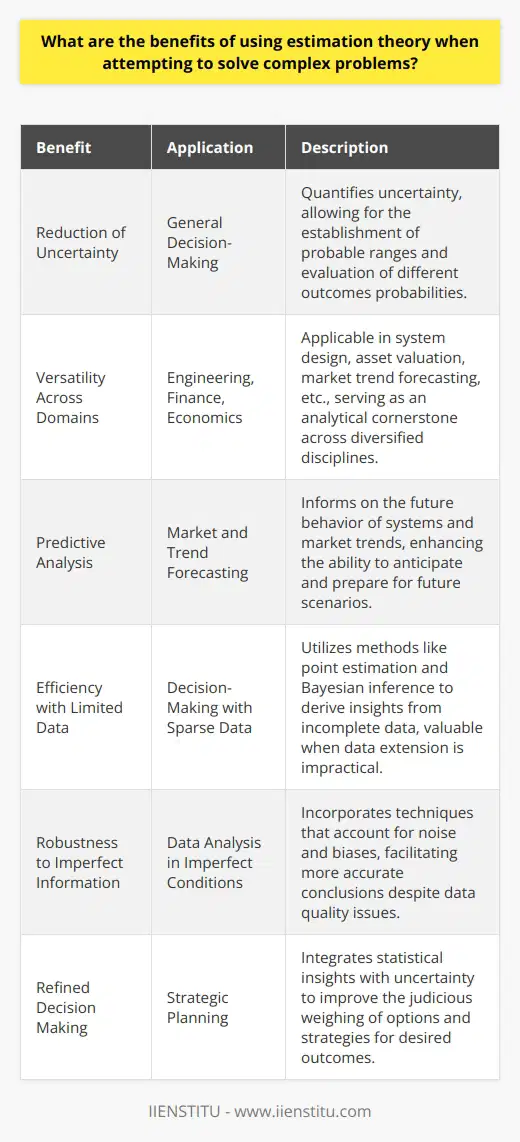
How does the application of statistical methods contribute to effective problem-solving in various fields?
**Statistical Methods in Problem-solving**
Statistical methods play a crucial role in effective problem-solving across various fields, including natural and social sciences, economics, and engineering. One primary contribution lies in the quantification and analysis of data.
**Data Quantification and Analysis**
Through descriptive statistics, researchers can summarize, organize, and simplify large data sets, enabling them to extract essential features and identify patterns. In turn, this fosters a deeper understanding of complex issues and aids in data-driven decision-making.
**Prediction and Forecasting**
Statistical methods can help predict future trends and potential outcomes with a certain level of confidence by extrapolating obtained data. Such prediction models are invaluable in fields as diverse as finance, healthcare, and environmental science, enabling key stakeholders to take proactive measures.
**Hypothesis Testing**
In the scientific process, hypothesis testing enables practitioners to make inferences about populations based on sample data. By adopting rigorous statistical methods, researchers can determine the likelihood of observed results occurring randomly or due to a specific relationship, thus validating or refuting hypotheses.
**Quality Control and Improvement**
In industries and manufacturing, statistical methods are applied in quality control measures to ensure that products and services meet established standards consistently. By identifying variations, trends, and deficiencies within production processes, statistical techniques guide improvement efforts.
**Design of Experiments**
Statistical methods are vital in the design of experiments, ensuring that the collected data is representative, reliable, and unbiased. By utilizing techniques such as random sampling and random assignment, researchers can mitigate confounding variables, increase generalizability, and establish causal relationships.
In conclusion, the application of statistical methods contributes to effective problem-solving across various fields by enabling data quantification, analysis, and prediction. Additionally, these methods facilitate hypothesis testing, quality control, and the design of experiments, fostering confidence in decision-making and enhancing outcomes.
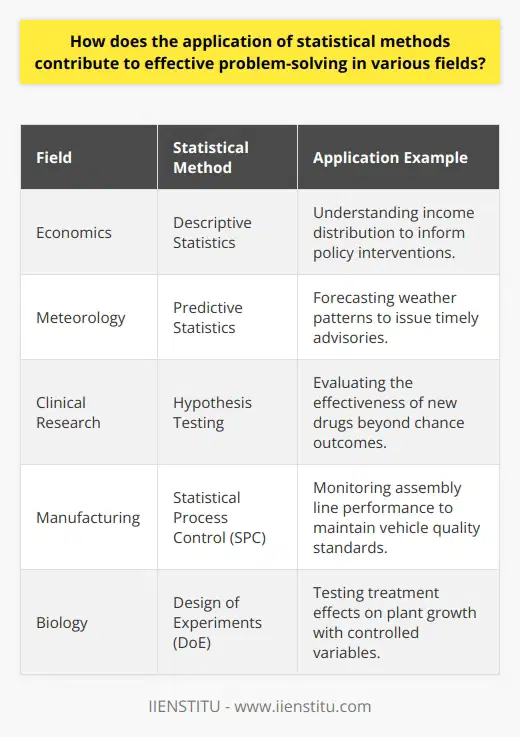
In what ways can statistical analysis enhance the decision-making process when facing complex challenges?
Statistical analysis in decision-making
Statistical analysis plays a crucial role in the decision-making process when facing complex challenges by enabling evidence-based decisions. It provides a systematic approach to accurately interpret data and transform it into meaningful and actionable insights. In turn, these insights enhance decision-making by reducing uncertainty, minimizing risks, and increasing confidence in the chosen strategy.
Quantitative approach
By adopting a quantitative approach, decision-makers can objectively evaluate various options using statistical techniques, such as regression analysis or hypothesis testing. This process facilitates the identification of patterns and relationships within the data, highlighting crucial factors that can significantly impact desired outcomes. Consequently, leaders can make informed decisions that optimize available resources and maximize benefits, ultimately increasing the overall success rate of implemented strategies.
Addressing biases
Statistical analysis helps to address cognitive biases that may otherwise cloud judgment and impede the decision-making process. These biases could include confirmation bias, anchoring bias, and availability heuristic, among others. Employing quantitative methods illuminates the influence these biases may have on subjective interpretations and assists decision-makers in mitigating potential negative impacts.
Risk analysis
In the context of complex challenges, risk analysis plays an essential role in decision-making. By employing statistical models, decision-makers can quantify risk, estimate probabilities of potential outcomes, and determine the optimal balance between risk and reward. This information can be invaluable for organizations when allocating resources, prioritizing projects, and managing uncertainty in dynamic environments.
Data-driven forecasts
Statistical analysis enables decision-makers to create accurate forecasts by extrapolating historical data and incorporating current trends. These forecasts can inform strategic planning, budget allocations, and resource management, reducing the likelihood of unforeseen obstacles and ensuring long-term success. In addition to providing a strong basis for future planning, these data-driven predictions also enable organizations to quickly adapt and respond to emerging trends and challenges.
In conclusion, statistical analysis is an invaluable tool for enhancing the decision-making process when facing complex challenges. By adopting a quantitative approach, addressing cognitive biases, conducting risk analysis, and producing data-driven forecasts, decision-makers can make informed choices that optimize outcomes and minimize potential risks.
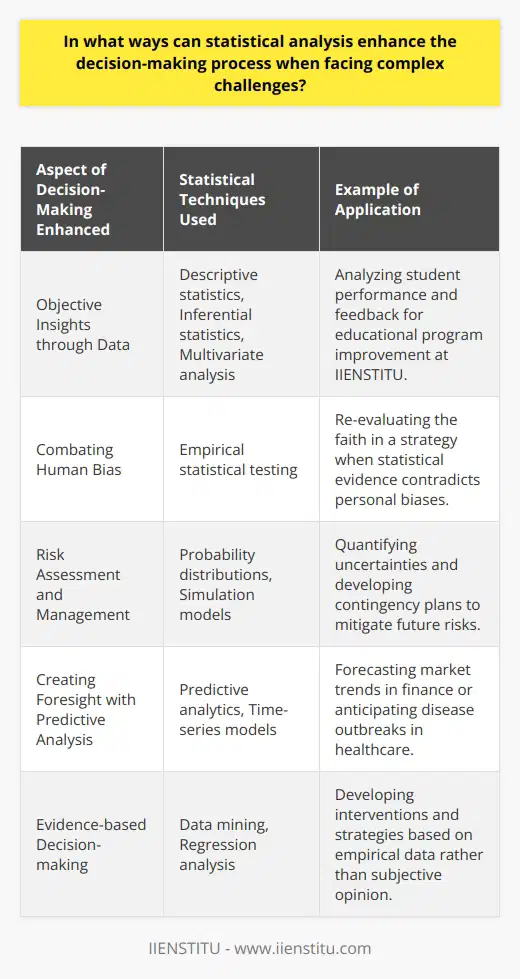
How can concepts like statistical hypothesis testing and regression analysis be applied to solve real-world problems and make informed decisions?
Applications of Hypothesis Testing
Statistical hypothesis testing can be a vital tool in decision-making processes, particularly when it comes to addressing real-world problems. In business, for example, managers may use hypothesis testing to determine whether a new product or strategy will lead to higher revenues or customer satisfaction. This can then inform their decisions on whether to invest in the product or strategy or explore other options. In medicine, researchers can use hypothesis testing to compare the effectiveness of a new treatment or intervention compared to standard care, which can provide valuable evidence to guide clinical practice.
Regression Analysis to Guide Decisions
Similarly, regression analysis is a powerful statistical technique used to understand relationships between variables and predict future outcomes. By modeling the connections between different factors, businesses can make data-driven decisions and develop strategies based on relationships found in historical data. For instance, companies can use regression analysis to forecast future sales, evaluate the return on investment for marketing campaigns, or identify factors that contribute to customer churn. In fields like public health, policymakers can use regression analysis to identify the effects of various interventions on health outcomes, leading to more effective resource allocation and targeting of mass media campaigns.
Assessing Real-World Solutions
The implementation of statistical hypothesis testing and regression analysis enables stakeholders across diverse disciplines to evaluate and prioritize potential solutions to complex problems. By identifying significant relationships between variables and outcomes, practitioners can develop evidence-based approaches to improve decision-making processes. These methods can be applied to problems in various fields, such as healthcare, public policy, economics, and environmental management, ultimately providing benefits for both individuals and society.
Ensuring Informed Decisions
In conclusion, both statistical hypothesis testing and regression analysis have a vital role in solving real-world problems and informing decisions. These techniques provide decision-makers with the necessary evidence to evaluate different options, strategies, or interventions to make the most appropriate choices. By incorporating these statistical methods into the decision-making process, stakeholders can increase confidence in their conclusions and improve the overall effectiveness of their actions, leading to better outcomes in various fields.

How does the use of descriptive and inferential statistics improve our understanding of complex problems and inform decision-making?
The Importance of Descriptive and Inferential Statistics in Problem Solving
Descriptive statistics provide essential context
Descriptive statistics summarize, organize, and simplify data, offering a comprehensive snapshot of a data set. By presenting data in a meaningful and easily interpretable manner, descriptive statistics enable researchers to understand and describe the key characteristics of a data set. This initial step in any data analysis is crucial for establishing context, identifying patterns, and generating hypotheses that contribute to a better understanding of complex problems.
Inferential statistics as a tool for decision-making
Inferential statistics, on the other hand, involve drawing conclusions and making generalizations about a larger population based on the analysis of a sample. Through hypothesis testing, confidence intervals, and regression analysis, researchers can determine relationships among variables, identify trends, and predict outcomes. By offering insights that go beyond the data at hand, inferential statistics enable researchers to make informed decisions and create strategies for tackling complex problems.
The synergy of descriptive and inferential statistics
In combination, both descriptive and inferential statistics enhance the understanding and decision-making process in various fields. Descriptive statistics provide a solid foundation by organizing and summarizing data, while inferential statistics enable researchers to delve deeper, uncovering relationships and trends that facilitate evidence-based decision-making. This combination empowers researchers to identify solutions and make more informed decisions when tackling complex problems.

What is the role of experimental design and sampling techniques in ensuring reliable and accurate conclusions when utilizing statistical analysis for problem-solving?
Role of Experimental Design
Experimental design plays a pivotal role in ensuring reliable and accurate conclusions in statistical analysis when solving problems. A well-defined experimental design outlines a systematic approach to conducting research, including the selection of participants, allocation of resources, and timing of interventions. It helps control potential confounding factors and biases, allowing researchers to attribute the study results to the intended interventions accurately. Moreover, experimental design enables researchers to quantify uncertainty in their findings through hypothesis testing, thereby establishing the statistical significance of their conclusions.
Sampling Techniques
Sampling techniques are another essential component in achieving valid and reliable results in statistical analysis. They ensure that the data collected from a population is representative of the whole, thus allowing for accurate generalizations. Proper sampling techniques, such as random sampling or stratified sampling, minimize the prevalence of sampling bias, which may otherwise lead to false or skewed conclusions. Additionally, determining the appropriate sample size—large enough to maintain statistical accuracy and minimize type I and type II errors—is crucial in enhancing the reliability and precision of study results.
Achieving Accurate Conclusions
To draw accurate conclusions in statistical analysis, researchers must ensure that their experimental design and sampling techniques are carefully planned and executed. This involves selecting the most appropriate methods in accordance with study goals and population demographics. Furthermore, vigilance regarding potential confounders and biases, and continuous monitoring of data quality, contribute to the validity and reliability of statistical findings for problem-solving.
Overall, a skillful combination of experimental design and sampling techniques is imperative for researchers to derive reliable and accurate conclusions from statistical analysis. By addressing potential pitfalls and adhering to best practices, this potent mix of methodologies allows for efficient problem-solving and robust insights into diverse research questions.

How do visualization techniques and exploratory data analysis contribute to a more effective interpretation of statistical findings in the context of real-world issues?
Enhancing Interpretation through Visualization Techniques
Visualization techniques play a significant role in interpreting statistical findings related to real-world issues. By converting complex data into visually appealing and easy-to-understand formats, these techniques allow decision-makers to quickly grasp the underlying patterns and trends. Graphs, plots, and charts are some common visualization tools that make data more accessible, aiding in the identification of outliers and hidden relationships among variables.
Exploratory Data Analysis: A Key Step
Exploratory data analysis (EDA) is critical for effective interpretation of statistical findings. This approach involves an initial assessment of the data's characteristics, emphasizing summarizing and visualizing key aspects. Employing EDA allows researchers to identify errors, missing values, and inconsistencies in the data, which is instrumental when addressing real-world issues. By obtaining insights into the dataset's structure and potential biases, analysts can formulate appropriate statistical models and ensure more accurate predictions and inferences.
Complementarity for Improved Data Interpretation
Combining visualization techniques and EDA contributes to a more effective interpretation of statistical findings by offering a complementary approach. Visualization supports the exploration of data, enabling pattern and relationship identification, while EDA provides a deeper insight into data quality and potential limitations. Together, these methods facilitate a comprehensive understanding of the data, allowing for a more informed decision-making process when addressing real-world issues.
In conclusion, visualization techniques and exploratory data analysis are essential tools for effectively interpreting statistical findings. By offering complementary benefits, they enhance decision-making processes and increase the likelihood of informed choices when examining real-world issues. As our world continues to produce vast amounts of data, these methods will remain critical to ensuring that statistical findings are accurate, relevant, and useful in solving pressing problems.

How does statistics help in problem-solving?
Role of Statistics in Problem-solving
Understanding the Problem
Statistics play a significant role in problem-solving by providing accurate data and quantitative evidence to better understand complex issues. The collection, analysis, and interpretation of numerical data enable decision-makers to observe trends, patterns, and relationships within the data, thus facilitating informed decision-making. To effectively solve problems, it is crucial to have a thorough understanding of the issue at hand, and statistics provide the necessary tools to explore and interpret the relevant data.
Identifying Patterns and Trends
Statistics help in identifying underlying patterns and trends within a dataset, which aids in understanding the problem's nature and behavior. By employing graphical and numerical techniques, statisticians can visualize relationships, fluctuations, and distributions within the data. Identifying these patterns can lead to the generation of hypotheses, proposing possible solutions, and implementing interventions to address the issues.
Evaluating Solutions
Once potential solutions are identified, statistics can be used to objectively evaluate their effectiveness by comparing the outcomes of different scenarios or interventions. Experimental designs such as controlled trials, surveys, and longitudinal studies are powerful tools for assessing the impact of problem-solving strategies. Furthermore, statistical significance testing allows decision-makers to determine the likelihood of results occurring by chance, providing more confidence in the selected solutions.
Making Informed Decisions
Through the use of statistical methods, decision-makers can be guided towards making more informed, evidence-based choices when solving problems. By basing decisions on empirical data, rather than relying on anecdotal evidence, intuition, or assumptions, organizations and policymakers can significantly improve the likelihood of producing successful outcomes. Statistical analysis enables the ranking of possible solutions according to their efficacy, which is crucial for resource allocation and prioritization within any setting.
In conclusion, statistics play a crucial role in problem-solving by providing a systematic and rigorous approach to understanding complex issues, identifying patterns and trends, evaluating potential solutions, and guiding informed decision-making. The use of quantitative data and statistical methods allows for greater objectivity, accuracy, and confidence in the process of solving problems and ultimately leads to more effective and efficient solutions.

What are the five statistical processes in solving a problem?
Statistical Processes Overview
The process of solving a problem using statistical methods involves five key steps. These steps enable researchers to analyze data and make inferences based on the results.
Defining the Problem
The first step in any statistical problem-solving process is to clearly define the problem. This involves identifying the research question, objective, or hypothesis that needs to be tested. The problem should be specific and clearly stated to guide the subsequent steps in the process.
Data Collection
Once the problem is defined, the next step is to collect data that will be used for analysis. Data can be collected through various methods, such as surveys, experiments, or secondary sources. The choice of data collection method should be based on the nature of the problem and the type of data required. It is important to collect data accurately and consistently to ensure the validity of the analysis.
Data Organization and Summarization
After collecting the data, it needs to be organized and summarized in a way that makes it easy to analyze. This may involve using tables, graphs, or charts to display the data. Descriptive statistics, such as measures of central tendency (mean, median, mode) and measures of dispersion (range, variance, standard deviation), can be used to summarize the data.
Analysis and Interpretation
At this stage, the data is analyzed using various statistical techniques to answer the research question or test the hypothesis. Inferential statistics, such as correlation analysis or hypothesis testing, can be employed to make inferences about the underlying population based on the sample data. It is crucial to choose the appropriate statistical method for the analysis, keeping in mind the research question and the nature of the data.
Drawing Conclusions and Recommendations
The final step in the statistical process is to draw conclusions from the analysis and provide recommendations based on the findings. This involves interpreting the results of the analysis in the context of the research question and making generalizations or predictions about the population. The conclusions and recommendations should be communicated effectively, ensuring that they are relevant and useful for decision-making or further research.
In conclusion, the five statistical processes in solving a problem are defining the problem, data collection, data organization and summarization, analysis and interpretation, and drawing conclusions and recommendations. These steps allow researchers to effectively analyze data and make informed decisions and predictions based on the results.

How can you use statistics effectively to resolve problems in everyday life?
Understanding the Basics of Statistics
Statistics provides a systematic method for individuals to collect, analyze and interpret data. Through this approach, one can efficiently utilize these results to tackle issues they may encounter daily. In the ensuing discussion, we will delve into the process of incorporating statistics to address these everyday concerns effectively.
Identifying the Problem
Firstly, it is essential to accurately outline the issue at hand. This preliminary stage entails formulating definitive questions, which will guide the data gathering process. Such specificity ensures the assembled information directly pertains to the focal problem and eliminates the possibility of superfluous distractions.
Collecting Relevant Data
Next, amassing reliable and diverse information allows for well-informed interpretations. To successfully achieve this, it is crucial to identify suitable sources that offer the pertinent data required for a comprehensive analysis. Moreover, obtaining data from diverse sources helps mitigate the potential for biased or skewed outcomes.
Implementing Appropriate Statistical Techniques
Upon compiling a robust dataset, the implementation of applicable statistical methods becomes crucial. Techniques such as descriptive statistics (e.g., mean, median, mode) or inferential statistics (e.g., regression, ANOVA) empower individuals to systematically extract informative conclusions. Ultimately, this data-driven process leads to a deeper understanding of the issue at hand and facilitates informed decision-making.
Interpreting Results and Drawing Conclusions
The final step involves rigorously assessing the conclusions derived from statistical analyses. This careful evaluation demands a thorough examination of any potential limitations or biases. Additionally, acknowledging alternative interpretations strengthens the overall argument by mitigating the risk of oversimplifying complex matters.
Incorporating Feedback and Adjustments
A critical aspect of effectively applying statistics revolves around the willingness to reevaluate one's approach. Engaging in an iterative process and incorporating feedback helps refine the problem-solving strategy, ultimately leading to more accurate and reliable solutions.
In summary, the proper use of statistics has the potential to greatly enhance individuals' ability to resolve problems in everyday life. By employing a methodical approach that involves identifying the issue, collecting relevant data, utilizing suitable techniques and critically evaluating conclusions, one can swiftly address concerns and make informed decisions.
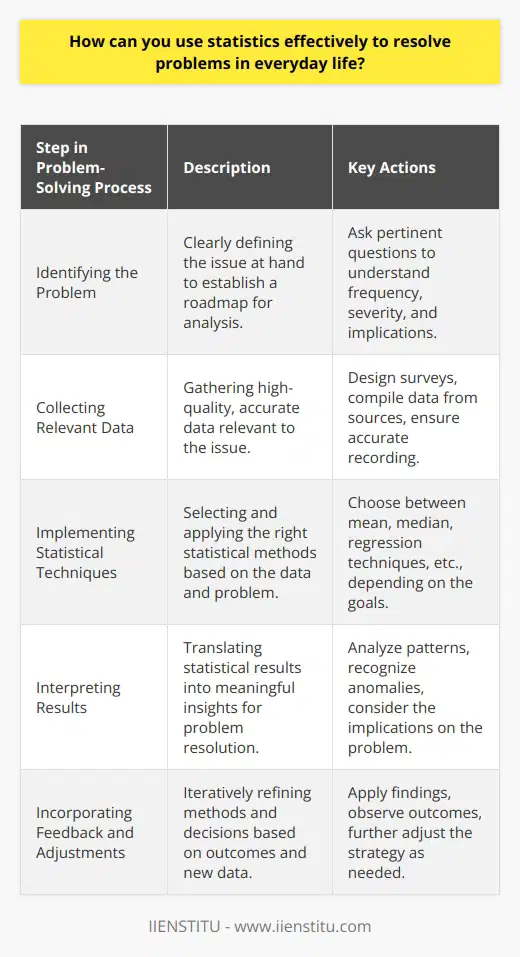
How can statistical inference be utilized to draw conclusions about a population when only a sample is available for analysis?
Statistical Inference and Population Analysis
Statistical inference is an essential tool in understanding populations. It allows scientists to analyze a small, representative subset or sample of a larger population. This way, we can extract conclusions about an entire population from the analysis of a sample.
Use of Sample Analysis
In sample analysis, researchers collect data from a smaller subset instead of assessing the entire population. It significantly reduces the required resources and time. Nevertheless, a sample must adequately represent the characteristics of the population for valid inferences.
Role of Probability
Probability plays a pivotal role in statistical inference. The application of probability theories provides information about the likelihood of particular results. The conclusions drawn about the population feature a degree of certainty conveyed by probability.
Statistical Tests
Stepping further, statistical tests employed in the process illuminate the differences between groups within the sample. They provide guidelines for finding if observed differences occurred due to chance. By employing these tests, we can generalize findings from a sample to the entire population.
Importance of Confidence Intervals
Confidence intervals are another critical component of statistical inference. They present the range of values within which we expect the population value to fall a certain percent of the time, say 95%. Confidence intervals reveal more about the population parameter than a single point estimate.
Conclusion and Future Predictions
Between sample analysis, probability, statistical tests, and confidence intervals, statistical inference enables efficient, accurate conclusions about large population groups. Its effective use facilitates not only a comprehensive understanding of the present population status but also assists in predicting future trends.
In a nutshell, statistical inference acts as a bridge connecting sample data to meaningful conclusions about the broader population. By analyzing a sample, predicting probabilities, applying statistical tests, and measuring confidence intervals, we can glean holistic insights about the entire population.
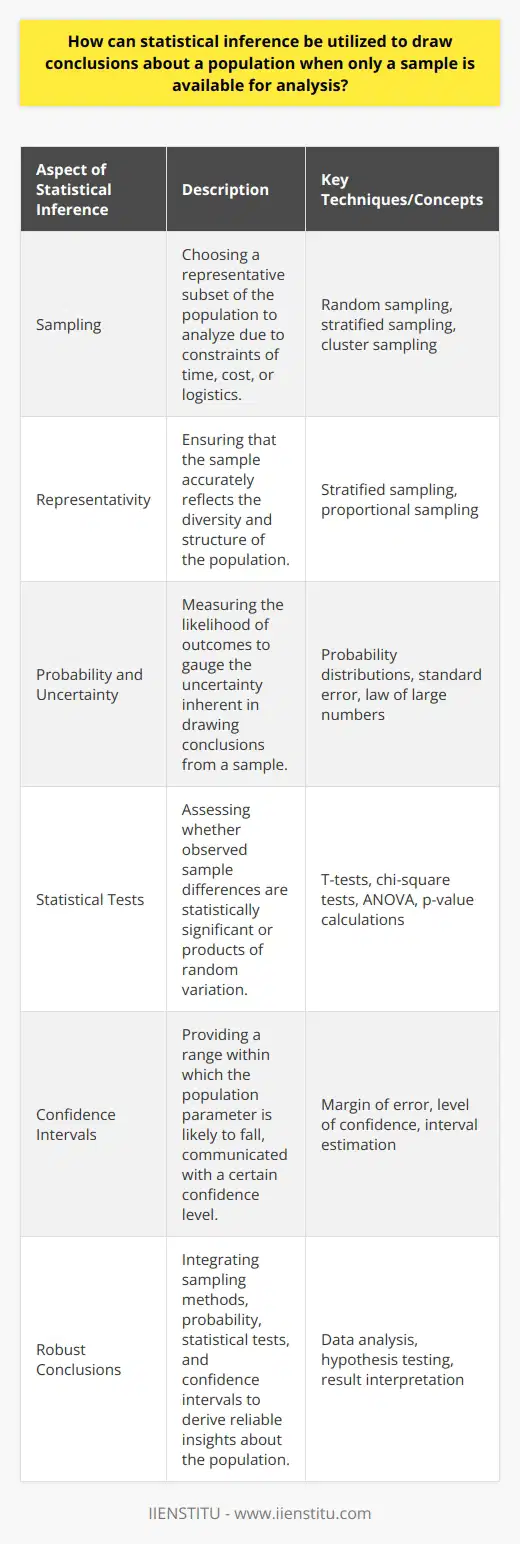
What are the key principles of robust statistical modeling, and how can these principles be applied to enhance the effectiveness of problem-solving efforts?
Understanding Robust Statistical Modeling Principles
Robust statistical modeling works on three key principles. They are the use of robust measures, an effective model selection strategy, and consideration of outliers. These principles play a crucial role to ensure the robustness of statistical results.
Applying Robust Measures
The first principle revolves around applying robust measures. These measures are resistant to the outliers in the data set. They work by minimizing the effect of extreme values. By using these robust measures, researchers can increase the accuracy of their statistical models.
Model Selection Strategy
Next comes the strategy for selecting the model. It involves choosing an appropriate statistical model that aligns well with the provided data set. In this case, the most reliable models are ones that demonstrate significant results and fit the data well. Selecting an efficient model, hence, can lead to more accurate predictions or inferences.
Addressing Outliers
Finally, a detailed consideration of outliers is vital. Outliers can skew the results of a model significantly. They need careful handling to prevent any bias in the final results. Recognizing and appropriately managing these outliers aids in maintaining the integrity of statistical findings.
Enhancing Problem-Solving Efforts
These principles, when applied effectively, can significantly enhance problem-solving efforts. By using robust measures, researchers can achieve more accurate results, increasing the credibility of their findings. A well-chosen model can enhance the interpretability and usefulness of the results. Furthermore, careful handling of outliers can prevent skewed results, ensuring more reliable conclusions. In essence, by embracing these principles, one can substantially elevate their problem-solving capabilities, making the process more efficient and effective. Thus, robust statistical modeling acts as a powerful tool in addressing various research questions and solving complex problems.
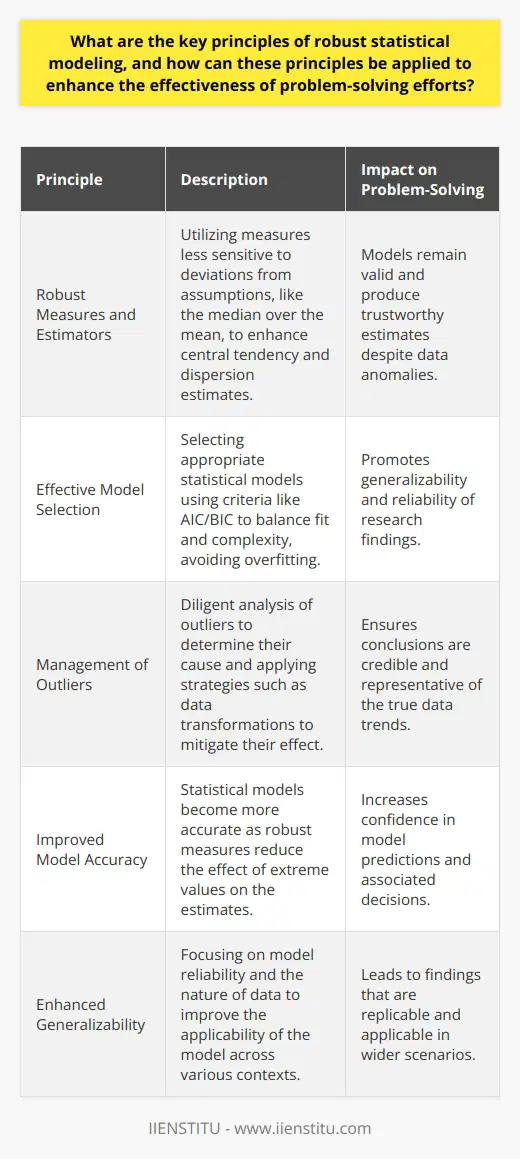
How can the utilizations of time series analysis in statistics support trend identification and forecasting in the context of complex/problem-solving situations?
Identifying Trends with Time Series Analysis:
A crucial aspect of time series analysis in statistics is trend identification. Time series analysis allows statisticians to discern patterns in data collected over time. These trends indicate changes in variables, creating a historical line that tracks these alterations across a span of time.
Support for Complex Problem Solving:
In complex problem-solving situations, time series analysis can provide valuable support. Specifically, it can facilitate independent, variable-dependent trend analysis and insights into relationships within data sequences. This is vital for complex situations requiring deeper analysis.
Time Series Analysis for Forecasting:
Another primary use of time series analysis is for forecast predictions in future scenarios. By analyzing the trends identified, predictions can suggest plausible future scenarios. This forecasting capability can be critical in planning and preparation for potential future events based on the observed trends.
Predictive Modeling:
Predictive modeling can be improved with time series analysis. It helps understand population trends or related metrics. By revealing underlying patterns, time series analysis supports data-driven decision making in complex situations.
In summary, time series analysis plays an instrumental role in statistics. Through trend identification and forecasting, it provides invaluable support for complex problem-solving situations. This statistical tool is essential for those working in an environment that requires a clear, predictive understanding of data over time.

How can statistics help with problem solving?
Effective Use of Statistics
Statistics offers efficient problem-solving tools. They provide the ability to measure, forecast, and make informed decisions. When faced with a problem, statistics help in gathering relevant data.
Understanding the Problem
Statistics helps to describe the problem objectively. Before proceeding with problem solving, a clear definition of the problem is necessary. Statistics describe problems quantitatively, bringing precision in problem definition.
Identifying Solutions
Statistics aids in identifying potential solutions. By using predictive analytics, statistics can forecast the outcomes of various solutions. Thus, it assists in the selection of most efficient solution based on the forecasted results.
Evaluating Results
Once a solution is implemented, statistics help in evaluation. They measure the effectiveness of the solution by comparing the outcomes with the predicted results.
Promoting Continuous Improvement
Statistics guide continuous improvement. They pinpoint deviations, enabling identification of areas of improvement. This leads to enhanced effectiveness in problem solving.
Statistics has a pivotal role in problem solving. The data-driven approach enhances the credibility of the problem-solving process and the ultimate solutions. The various statistical tools improve both the efficiency and effectiveness, leading to better solutions.
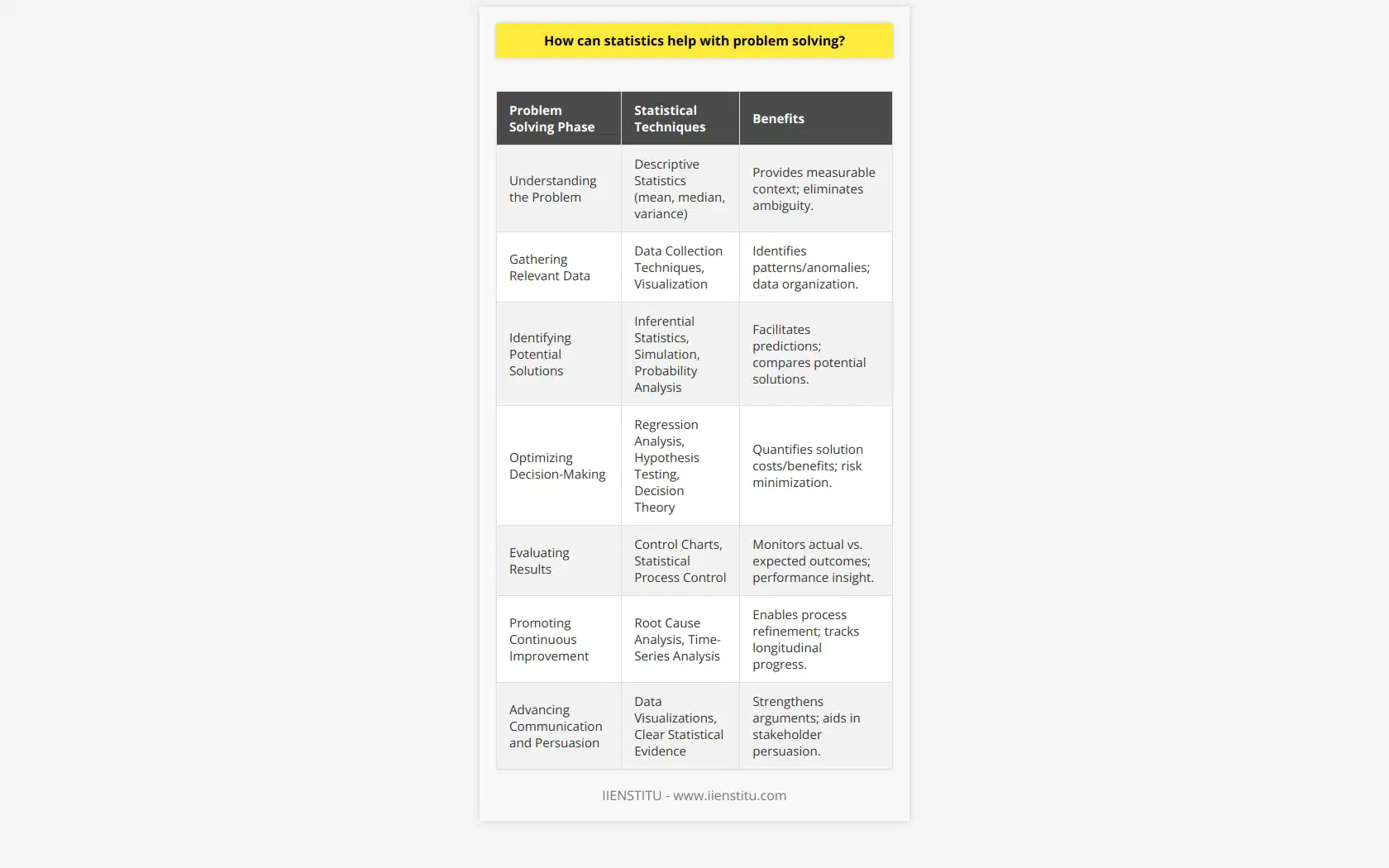
Why is data analysis important in problem solving?
Data Analysis and Problem-Solving: A Crucial Connection
Data analysis stands as a critical tool in problem solving in the contemporary business environment. Essentially, it offers insightful measurements of challenges. By examining data, we uncover patterns and trends to identify problems.
Identification of Issues
The initial step in problem-solving involves the recognition of a problem. It is here that data analysis proves vital. It grants a robust basis for this recognition, presenting objective rather than subjective identifiers.
Understanding the Nature of Problems
Once we identify a problem, we must understand its nature. In-depth data analysis can provide a detailed insight into why problems arise. It examines multiple variable relationships, often revealing root causes.
Generating Solutions
Data analysis aids in creating suitable solutions. By understanding the problem from a data perspective, we can draw up potential fixes. These solutions are often grounded on empirical evidence, hence sound and reliable.
Evaluating Outcomes
After solution implementation, evaluation follows closely. Analyzing data post-implementation helps measure the effectiveness of the solution. It provides a measure on the success of the problem-solving process.
In conclusion, data analysis is a strong ally in problem-solving. It facilitates issue identification, enhances understanding, helps to generate solutions, and evaluates outcomes. By utilizing this tool, we can significantly improve our problem-solving efforts, leading to more effective and measurable results.
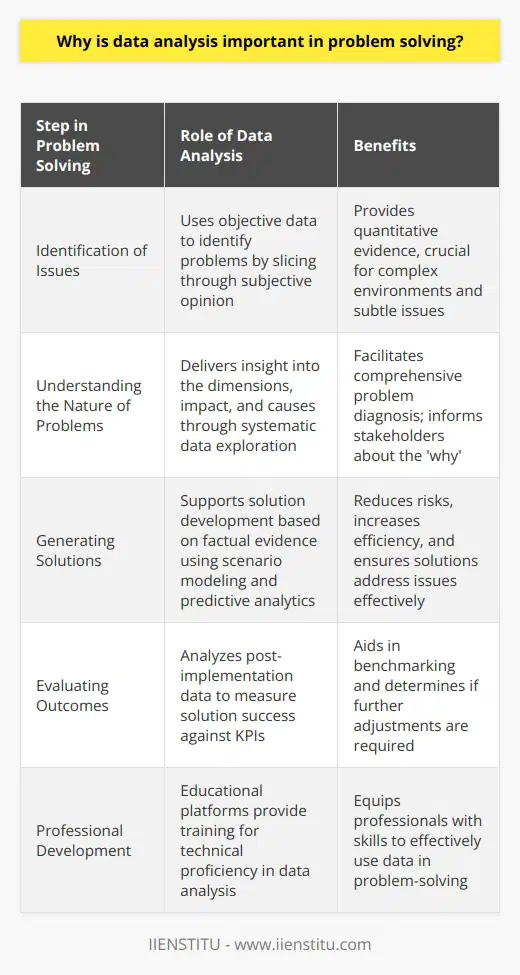
How does statistics make you a better thinker?
Enhancing Reasoning and Decision Making Skills
Statistics equips one with necessary tools to question and interpret data intelligently. It sharpens critical reasoning abilities by offering ways to identify patterns or anomalies, thus improving decision-making efficiency.
Understanding Probabilities and Predictions
Statistics introduces individuals to the concept of probability, enabling them to weigh the likelihood of different scenarios accurately. Consequently, it allows them to make precise and informed predictions, honing their thinking and analytical skills.
Building Quantitative Literacy
Statistics promotes quantitative literacy, a vital skill in a data-driven world. Understanding numerical information helps individuals decipher complex data and convert it into actionable insights. This heightens critical thinking abilities and enables better understanding of the world.
Critiquing Data Effectively
Statistics improves a person's ability to critically analyze presented data. Using statistical tools, one can identify manipulation or misinterpretation in data, preventing them from taking misleading information at face value.
Developing Logical Reasoning
Statistics fosters effective problem-solving skills by inciting logical reasoning. It drives individuals to meticulously analyze data, look for patterns and draw logical conclusions, thus streamlining strategic decision-making processes.
In conclusion, mastering the use of statistics can effectively enhance a person's thinking capacity. It works on multiple fronts ranging from decision-making to quantitative literacy to critiquing data, making one a more discerning and astute individual. Statistics, therefore, plays a pivotal role in developing vital cognitive abilities.
